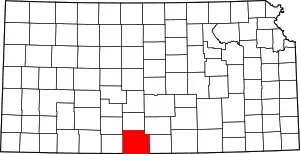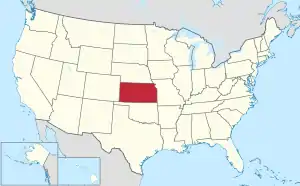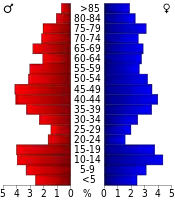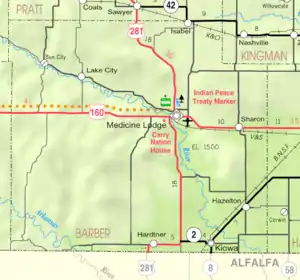Barber County | |
|---|---|
 Medicine Lodge Stockade Museum (left) and Carry A. Nation house (right) in Medicine Lodge | |
 Location within the U.S. state of Kansas | |
 Kansas's location within the U.S. | |
| Coordinates: 37°14′N 98°41′W / 37.233°N 98.683°W | |
| Country | |
| State | |
| Founded | February 26, 1867 |
| Named for | Thomas W. Barber |
| Seat | Medicine Lodge |
| Largest city | Medicine Lodge |
| Area | |
| • Total | 1,136 sq mi (2,940 km2) |
| • Land | 1,134 sq mi (2,940 km2) |
| • Water | 2.1 sq mi (5 km2) 0.2% |
| Population | |
| • Total | 4,228 |
| • Density | 3.7/sq mi (1.4/km2) |
| Time zone | UTC−6 (Central) |
| • Summer (DST) | UTC−5 (CDT) |
| Area code | 620 |
| Congressional district | 4th |
| Website | barber.ks.gov |
Barber County is a county located in the south-central portion of the U.S. state of Kansas. Its county seat and most populous city is Medicine Lodge.[2] As of the 2020 census, the county population was 4,228.[1] The county was named for Thomas Barber, an abolitionist who was killed in Douglas County in 1855 during the Wakarusa War.[3]
History
For many millennia, the Great Plains of North America was inhabited by nomadic Native Americans.
In 1854, the Kansas Territory was organized, then in 1861 Kansas became the 34th U.S. state.
In 1873, Barber County was established, and named for Thomas W. Barber.
Geography
According to the U.S. Census Bureau, the county has a total area of 1,136 square miles (2,940 km2), of which 1,134 square miles (2,940 km2) is land and 2.1 square miles (5.4 km2) (0.2%) is water.[4]
Adjacent counties
- Pratt County (north)
- Kingman County (northeast)
- Harper County (east)
- Alfalfa County, Oklahoma (southeast)
- Woods County, Oklahoma (southwest)
- Comanche County (west)
- Kiowa County (northwest)
Major highways
Demographics

| Census | Pop. | Note | %± |
|---|---|---|---|
| 1880 | 2,661 | — | |
| 1890 | 7,973 | 199.6% | |
| 1900 | 6,594 | −17.3% | |
| 1910 | 9,916 | 50.4% | |
| 1920 | 9,739 | −1.8% | |
| 1930 | 10,178 | 4.5% | |
| 1940 | 9,073 | −10.9% | |
| 1950 | 8,521 | −6.1% | |
| 1960 | 8,713 | 2.3% | |
| 1970 | 7,016 | −19.5% | |
| 1980 | 6,548 | −6.7% | |
| 1990 | 5,874 | −10.3% | |
| 2000 | 5,307 | −9.7% | |
| 2010 | 4,861 | −8.4% | |
| 2020 | 4,228 | −13.0% | |
| U.S. Decennial Census[7] 1790-1960[8] 1900-1990[9] 1990-2000[10] 2010-2020[1] | |||
As of the 2000 census,[11] there were 5,307 people, 2,235 households, and 1,510 families residing in the county. The population density was 5 people per square mile (1.9 people/km2). There were 2,740 housing units at an average density of 2 per square mile (0.77/km2). The racial makeup of the county was 97.06% White, 0.38% Black or African American, 0.58% Native American, 0.09% Asian, 0.89% from other races, and 1.00% from two or more races. Hispanic or Latino of any race were 2.02% of the population.
There were 2,235 households, out of which 28.70% had children under the age of 18 living with them, 58.70% were married couples living together, 6.50% had a female householder with no husband present, and 32.40% were non-families. 29.90% of all households were made up of individuals, and 17.00% had someone living alone who was 65 years of age or older. The average household size was 2.35 and the average family size was 2.91.
In the county, the population was spread out, with 25.00% under the age of 18, 5.80% from 18 to 24, 23.20% from 25 to 44, 24.50% from 45 to 64, and 21.50% who were 65 years of age or older. The median age was 43 years. For every 100 females there were 92.40 males. For every 100 females age 18 and over, there were 89.40 males.
The median income for a household in the county was $33,407, and the median income for a family was $40,234. Males had a median income of $29,806 versus $20,046 for females. The per capita income for the county was $16,627. About 7.50% of families and 10.10% of the population were below the poverty line, including 12.60% of those under age 18 and 4.90% of those age 65 or over.
Government
Barber County Is a Republican stronghold. The last Democrat to carry this county was Lyndon B. Johnson in 1964.
Presidential elections
| Year | Republican | Democratic | Third party | |||
|---|---|---|---|---|---|---|
| No. | % | No. | % | No. | % | |
| 2020 | 2,014 | 85.99% | 291 | 12.43% | 37 | 1.58% |
| 2016 | 1,850 | 81.82% | 286 | 12.65% | 125 | 5.53% |
| 2012 | 1,772 | 76.58% | 482 | 20.83% | 60 | 2.59% |
| 2008 | 1,833 | 74.45% | 598 | 24.29% | 31 | 1.26% |
| 2004 | 1,782 | 74.16% | 588 | 24.47% | 33 | 1.37% |
| 2000 | 1,755 | 70.26% | 637 | 25.50% | 106 | 4.24% |
| 1996 | 1,696 | 62.15% | 730 | 26.75% | 303 | 11.10% |
| 1992 | 1,225 | 42.52% | 759 | 26.35% | 897 | 31.14% |
| 1988 | 1,539 | 56.87% | 1,118 | 41.32% | 49 | 1.81% |
| 1984 | 2,112 | 71.84% | 806 | 27.41% | 22 | 0.75% |
| 1980 | 1,872 | 62.53% | 914 | 30.53% | 208 | 6.95% |
| 1976 | 1,568 | 50.43% | 1,494 | 48.05% | 47 | 1.51% |
| 1972 | 2,308 | 74.26% | 727 | 23.39% | 73 | 2.35% |
| 1968 | 2,023 | 60.55% | 1,027 | 30.74% | 291 | 8.71% |
| 1964 | 1,758 | 48.51% | 1,845 | 50.91% | 21 | 0.58% |
| 1960 | 2,703 | 66.48% | 1,347 | 33.13% | 16 | 0.39% |
| 1956 | 2,698 | 68.32% | 1,241 | 31.43% | 10 | 0.25% |
| 1952 | 3,071 | 74.09% | 1,028 | 24.80% | 46 | 1.11% |
| 1948 | 2,013 | 50.92% | 1,891 | 47.84% | 49 | 1.24% |
| 1944 | 2,140 | 58.28% | 1,501 | 40.88% | 31 | 0.84% |
| 1940 | 2,389 | 52.84% | 2,074 | 45.87% | 58 | 1.28% |
| 1936 | 1,816 | 39.41% | 2,774 | 60.20% | 18 | 0.39% |
| 1932 | 1,671 | 40.88% | 2,321 | 56.78% | 96 | 2.35% |
| 1928 | 2,984 | 76.43% | 871 | 22.31% | 49 | 1.26% |
| 1924 | 2,218 | 58.25% | 909 | 23.87% | 681 | 17.88% |
| 1920 | 2,400 | 66.45% | 1,098 | 30.40% | 114 | 3.16% |
| 1916 | 1,632 | 40.97% | 2,061 | 51.74% | 290 | 7.28% |
| 1912 | 295 | 12.73% | 883 | 38.11% | 1,139 | 49.16% |
| 1908 | 1,097 | 53.72% | 864 | 42.31% | 81 | 3.97% |
| 1904 | 967 | 58.29% | 566 | 34.12% | 126 | 7.59% |
| 1900 | 862 | 51.16% | 783 | 46.47% | 40 | 2.37% |
| 1896 | 597 | 44.45% | 729 | 54.28% | 17 | 1.27% |
| 1892 | 883 | 37.75% | 0 | 0.00% | 1,456 | 62.25% |
| 1888 | 977 | 48.80% | 710 | 35.46% | 315 | 15.73% |
Laws
Barber County allows the sale of liquor at not only liquor stores but also in restaurants.[13]
Economy
Education
Unified school districts
Communities

Cities
Unincorporated communities
Ghost towns
- Forest City
- Lasswell
- Mingona
- Pixley
Townships
Barber County is divided into eighteen townships. None of the cities within the county are considered governmentally independent, and all figures for the townships include those of the cities. In the following table, the population center is the largest city (or cities) included in that township's population total, if it is of a significant size.
See also
- Community information for Kansas
References
- 1 2 3 "QuickFacts; Barber County, Kansas; Population, Census, 2020 & 2010". United States Census Bureau. Archived from the original on August 15, 2021. Retrieved August 15, 2021.
- ↑ "Find a County". National Association of Counties. Archived from the original on May 31, 2011. Retrieved June 7, 2011.
- ↑ "Barber County KS". Archived from the original on June 6, 2014. Retrieved June 4, 2014.
- ↑ "US Gazetteer files: 2010, 2000, and 1990". United States Census Bureau. February 12, 2011. Retrieved April 23, 2011.
- ↑ National Atlas Archived December 5, 2008, at the Wayback Machine
- ↑ "U.S. Census Bureau TIGER shape files". Archived from the original on May 23, 2017. Retrieved December 5, 2017.
- ↑ "U.S. Decennial Census". United States Census Bureau. Retrieved July 21, 2014.
- ↑ "Historical Census Browser". University of Virginia Library. Retrieved July 21, 2014.
- ↑ "Population of Counties by Decennial Census: 1900 to 1990". United States Census Bureau. Retrieved July 21, 2014.
- ↑ "Census 2000 PHC-T-4. Ranking Tables for Counties: 1990 and 2000" (PDF). United States Census Bureau. Archived (PDF) from the original on March 27, 2010. Retrieved July 21, 2014.
- ↑ "U.S. Census website". United States Census Bureau. Retrieved January 31, 2008.
- ↑ "Dave Leip's Atlas of U.S. Presidential Elections".
- ↑ "Map of Wet and Dry Counties" (PDF). Alcoholic Beverage Control, Kansas Department of Revenue. Archived (PDF) from the original on October 25, 2012.
Further reading
- Chosen Land: A History of Barber County, Kansas; The Barber County History Committee; Taylor Printing; 1980.
- Standard Atlas of Barber County, Kansas; Geo. A. Ogle & Co; 76 pages; 1923.
- Standard Atlas of Barber County, Kansas; Geo. A. Ogle & Co; 64 pages; 1905.
External links
- County
- Barber County - Official
- Barber County - Directory of Public Officials
- Barber County - Development Archived 2018-09-28 at the Wayback Machine
- Maps